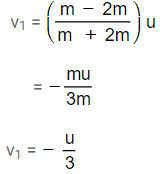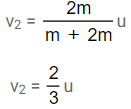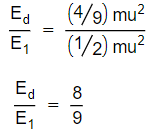 Multiple Choice Questions
Multiple Choice QuestionsA proton is about 1840 times heavier than an electron. When it is accelerated by a potential difference of 1 kV, its kinetic energy will be
1840 keV
1/1840 keV
1 keV
920 keV
A radioactive substance decays to 1/16th of its initial activity in 40 days. The half-life of the radioactive substance expressed in days is
2.5
5
10
20
A neutron makes a head-on elastic collision with a stationary deuteron. The fractional energy loss of the neutron in the collision is
16/81
8/9
8/27
2/3
B.
8/9

One deuteron consists of one proton and one neutron. As the mass of a proton and a neutron is approximately same (≈ 1.67 × 10-27 kg ), we assume that the mass of the neutron be m and the mass of the deuteron be 2mas the electron mass is negligibly small compared to that of proton and neutron.
Let the initial velocity of the neutron be u. As the deuteron is initially at rest, the final velocity of the neutron is

And the velocity of the deutron is

Total energy before collision is
E1 = 1/2 mu2
After the collision, the energy gained by the deuteron is

Nuclear fusion is possible
only between light nuclei
only between heavy nuclei
between both light and heavy nuclei
only between nuclei which are stable against β-decay
Radioactive nuclei that are injected into a patient collect at certain sites within its body, undergoing radioactive decay and emitting electromagnetic radiation. These radiations can then be recorded by a detector. This procedure provides an important diagnostic tool called
gamma camera
CAT scan
radiotracer technique
gamma ray spectrosccopy
In a material medium, when a positron meets an electron both the particles annihilate leading to the emission of two gamma ray photons. This process forms the basis of an important diagnostic procedure called
MRI
PET
CAT
SPECT
Assertion: Radioactive nuclei emit β- particles.
Reason: Electrons exist inside the nucleus.
if both assertion and reason are true and the reason is the correct explanation of the assertion
if both assertion and reason are true and the reason is not the correct explanation of the assertion
if assertion is true but reason is false
If both assertion and reason are false statements
Assertion: Neutrons penetrate matter more readily as compared to protons.
Reason: Neutrons are slightly more massive than protons.
if both assertion and reason are true and the reason is the correct explanation of the assertion
if both assertion and reason are true and the reason is not the correct explanation of assertion
if assertion is true but reason is false
if both assertion and reason are false statements
Assertion: Quasar emits radiowaves more than radio galaxy.
Reason: Quasar has very small size
If both the assertion and reason are true and reason is a correct explanation of the assertion.
If both assertion and reason are true but assertion is not a correct explanation of the assertion.
If the assertion is true but the reason is false.
If both assertion and reason are false.
Mass of the proton is 1840 times that of electron. It is accelerated through a potential difference of 1V. Find its kinetic energy.
6 eV
2 eV
10 eV
1 eV
